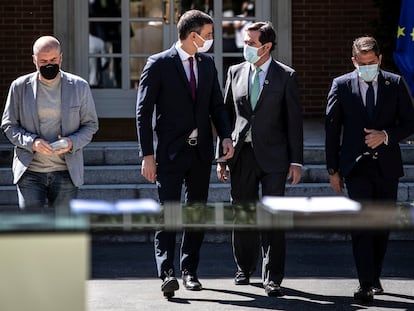Fresh outbreaks dampen Spanish tourism sector’s hopes for summer season
The number of people registered as unemployed rose by 29,780 in August while the Social Security system gained 6,822 new contributors

August was supposed to confirm a progressive recovery of the Spanish labor market following the debacle triggered by the Covid-19 pandemic and one of the world’s strictest lockdowns.
According to Social Security Minister José Luis Escrivá, 132,000 new jobs were created in the first three weeks of the month. But the upward trend was reversed by fresh coronavirus outbreaks and travel advisories introduced by many countries that recommended not going to Spain. The slowdown began in late July, when the United Kingdom introduced a quarantine for travelers arriving from the country.
This has impacted the tourism industry, which is usually a leading source of Spanish job creation at this time of the year and contributes more than 12% of Spain’s gross domestic product (GDP). And hotels have already announced plans to close in late August due to a lack of demand, in a move that could have an adverse effect on September, traditionally still a strong month for tourism.
Spain has a 15% jobless rate and the central bank is expecting this figure to be anywhere between 18.1% and 23.6% by the end of the year
A total of 211,566 job contracts ended on the last day of August in a move that plays out every year, as the peak of the summer season draws to an end and seasonal workers leave their posts at bars, restaurants and hotels.
There were also fewer hirings this summer to begin with. “The drop in hirings, of 26% year-on-year, indicates that we are still far from a normalization of the labor market,” said Valentín Bote, director of Randstad Research, which analyzes employment trends.
There was a slight rise in employment figures in August as the Social Security system registered 6,822 new contributors – considered a measure of job creation. But this did little to make up for the approximately 688,000 jobs that have been lost to Covid-19. Ever since the confinement measures began to be gradually lifted in April, the labor market has recovered around 333,000 Social Security contributors.
Furloughed workers
Meanwhile, the number of people registered as unemployed rose by 29,780, representing the lowest figure for a month of August since 2016, partly due to the fact that many workers have been furloughed and are not included in unemployment figures as they technically still have a job. But as the state-funded program comes to an end there are fears that many could ultimately be sent home for good as businesses find themselves unable to survive.
The number of furloughed workers went down by around 300,000 to 800,000 in August. Three out of four of these workers have now exited the ERTE job retention scheme, introduced by the government to stem the job losses caused by the strict confinement. Nearly half a million companies filed for ERTEs in response to the coronavirus lockdown, which forced the temporary closure of businesses across the country.
According to Eurostat, the EU’s statistics office, the number of employed persons in Spain dropped by around 8% in the first half of the year, nearly three times higher than in other European countries.
Spain has a 15% jobless rate and the central bank is expecting this figure to be anywhere between 18.1% and 23.6% by the end of the year, depending on the severity of the Covid-19 situation.
By comparison, the jobless rate in late 2019 was 14.1%. But the Bank of Spain has warned that the furloughing scheme is skewing the unemployment figures, and that “the jobless variable must be taken with a pinch of salt.”
English version by Susana Urra.
Tu suscripción se está usando en otro dispositivo
¿Quieres añadir otro usuario a tu suscripción?
Si continúas leyendo en este dispositivo, no se podrá leer en el otro.
FlechaTu suscripción se está usando en otro dispositivo y solo puedes acceder a EL PAÍS desde un dispositivo a la vez.
Si quieres compartir tu cuenta, cambia tu suscripción a la modalidad Premium, así podrás añadir otro usuario. Cada uno accederá con su propia cuenta de email, lo que os permitirá personalizar vuestra experiencia en EL PAÍS.
¿Tienes una suscripción de empresa? Accede aquí para contratar más cuentas.
En el caso de no saber quién está usando tu cuenta, te recomendamos cambiar tu contraseña aquí.
Si decides continuar compartiendo tu cuenta, este mensaje se mostrará en tu dispositivo y en el de la otra persona que está usando tu cuenta de forma indefinida, afectando a tu experiencia de lectura. Puedes consultar aquí los términos y condiciones de la suscripción digital.
More information
Últimas noticias
Most viewed
- Sinaloa Cartel war is taking its toll on Los Chapitos
- Oona Chaplin: ‘I told James Cameron that I was living in a treehouse and starting a permaculture project with a friend’
- Reinhard Genzel, Nobel laureate in physics: ‘One-minute videos will never give you the truth’
- Why the price of coffee has skyrocketed: from Brazilian plantations to specialty coffee houses
- Silver prices are going crazy: This is what’s fueling the rally










































